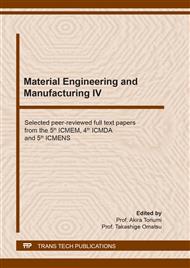p.35
p.45
p.52
p.58
p.66
p.72
p.81
p.87
p.94
Research on Surface Roughness Prediction Model of Ultrasonic Assisted Grinding by Response Surface Method
Abstract:
In this paper, through a series of grinding experiments with different machining parameters on the surface of the workpiece, the surface roughness under different machining parameters are obtained The surface roughness prediction model is constructed by the response surface method. The effects of feed rate, amplitude, and spindle speed on the surface roughness are analyzed. The results show that the surface quality of ultrasonic-assisted grinding is better than that of conventional grinding. Amplitude has the most prominent effect on the improvement of surface quality, followed by the spindle speed. The feed rate has little effect on the surface roughness. The model can predict 93.71% of the experimental results and the prediction error of the model is lower than 5%.
Info:
Periodical:
Pages:
66-71
Citation:
Online since:
September 2021
Authors:
Keywords:
Price:
Сopyright:
© 2021 Trans Tech Publications Ltd. All Rights Reserved
Share:
Citation:


